Last spring, I decided to fix up one of the gardens in the front yard as well as make an additional garden with a slate rock walkway. One of the issues I faced with the new walkway has been a major overtaking of weeds. In order to make this space a little more manageable and aesthetically pleasing, I decided to add creeping thyme Thymus praecox. I planted the seeds directly into the soil, but I couldn’t keep track of their growth. The creeping thyme I had planted was now competing with the weeds and I was concerned about removing the new growth of creeping thyme along with those dreaded weeds.
Back in May, I started a few of the seeds indoors in egg crates. I purchased a packet of 10,000 of dwarf creeping thyme seeds from MySeeds.Co and have been using Black Gold all-purpose potting soil. I discovered using larger containers worked better than the egg crates and I was able to extract the new growth easier and transplant them into the ground more efficiently. If you would like to try growing creeping thyme yourself, here are a few helpful tips.
Instructions for growing creeping thyme successfully from seed:
1. Sow seeds in containers, taking care to cover the seeds lightly with soil.
2. The soil should be kept between 64-75 degrees Fahrenheit.
3. Germination will take place between 14-21 days.
4. The soil should be kept moist, but not too wet. I use a small spray bottle and this seems to give a nice amount of control in order to prevent overwatering.
5. As the plants get bigger, you can proceed with regular watering to maintain proper moisture.
The following photographs are from my experience of growing creeping thyme seeds:
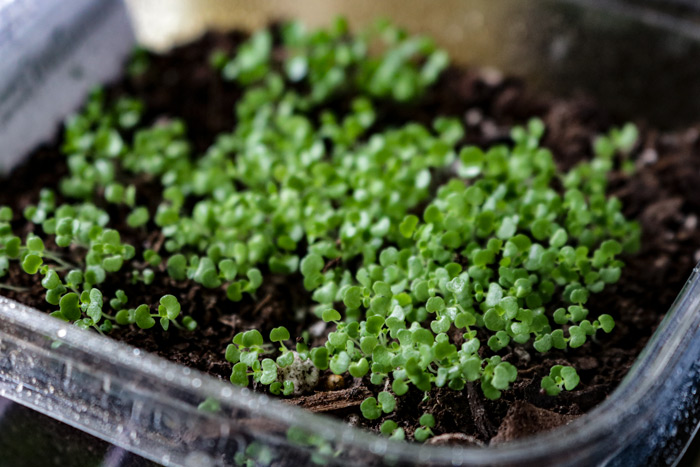
Young creeping thyme started from seed growing in clear plastic containers.
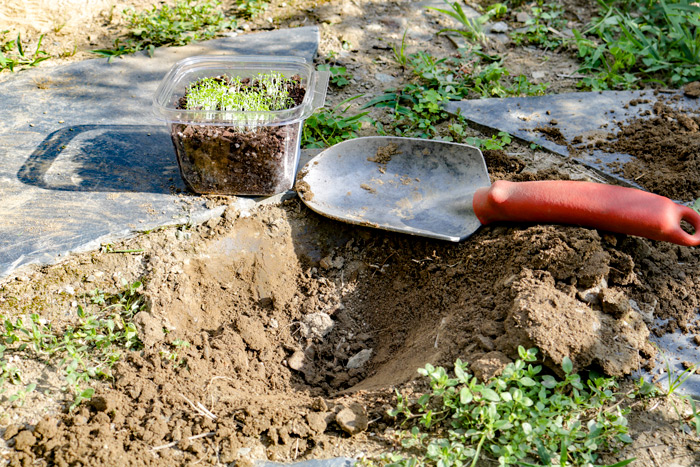
A hole dug for planting creeping thyme in the ground.
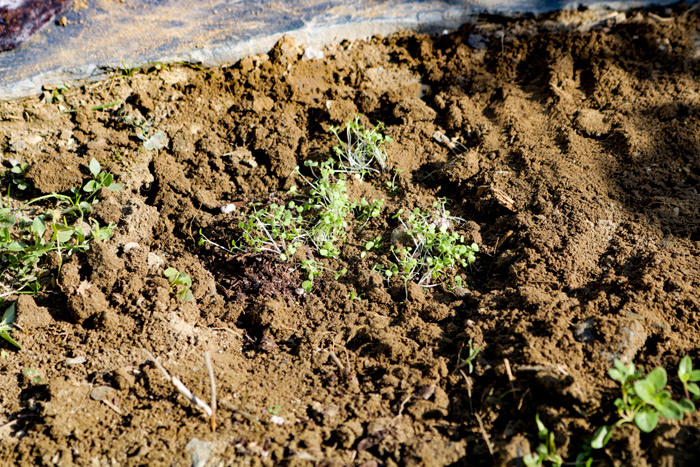
Freshly planted creeping thyme in the garden pathway.
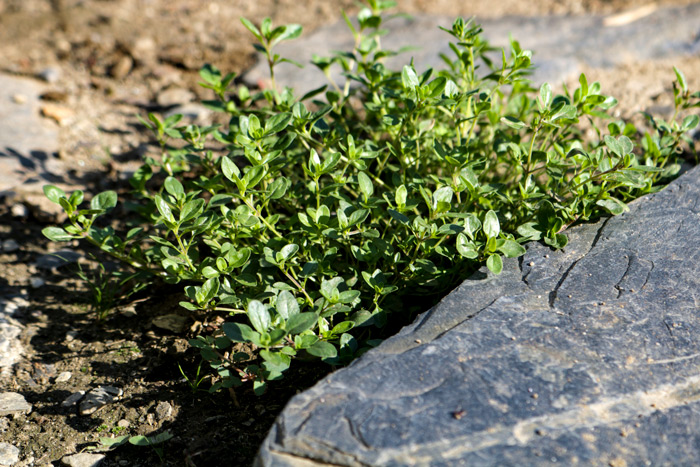
Creeping thyme that I planted earlier in the season with the instructions I have mentioned above.
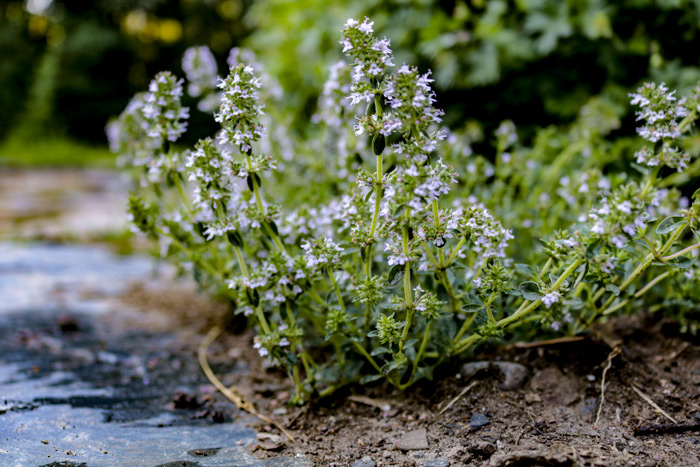
This is creeping thyme that I planted last summer.
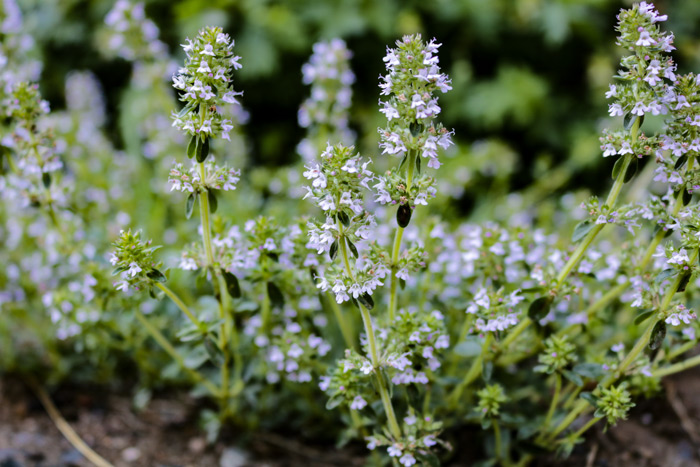
A close-up view of creeping thyme that I had planted last year.
Creeping thyme grows well in USDA hardy zones 4-9. Make sure to plant creeping thyme 8 to 12 inches apart to allow for proper spreading. It will grow in well-drained soil and thrive in full sun to light shade areas. Creeping thyme should be pruned in the spring in order to maintain a compact appearance and again after the small white flowers are done blooming if additional shaping is preferred. It can be walked on and does well as a lawn replacement, among stepping zones and pathways. It is also edible with a flavor and scent similar to that of mint.
I’m hoping by next spring, to see the whole path covered with this beautiful creeping thyme. We will have to wait and see what happens next year!
It is now the summer of 2020 and I’m pleased to report that my walkway is now completely covered with creeping thyme. What a difference these beautiful flowers have made visually and they have indeed, provided an excellent source for weed control. Here are a few photographs that I had taken last month and I hope you have success with growing creeping thyme yourself, too!
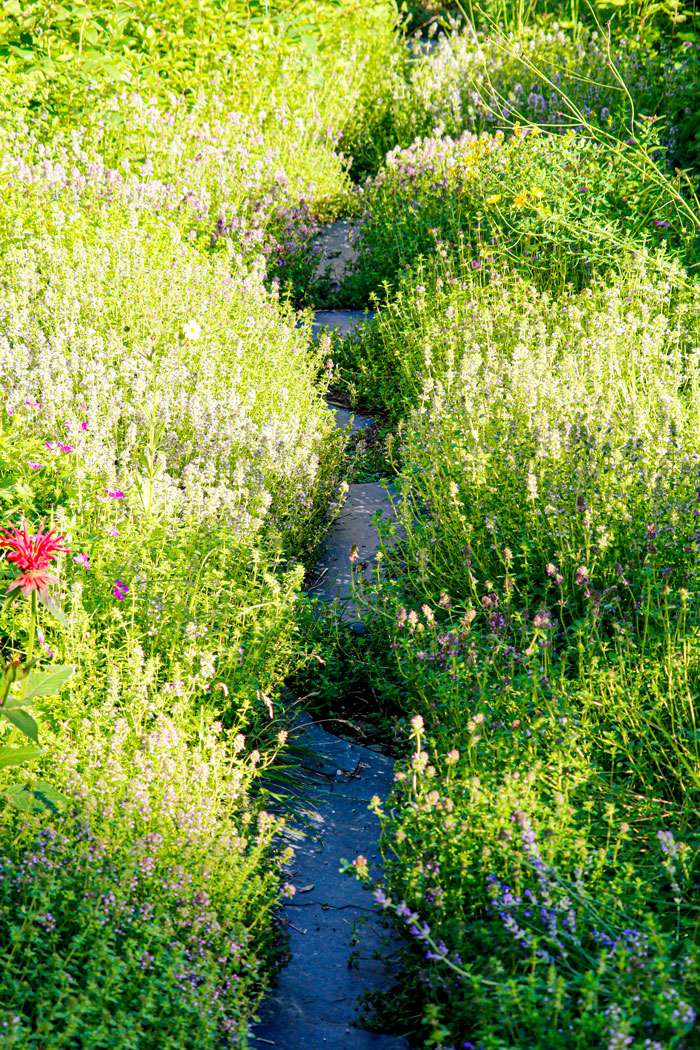
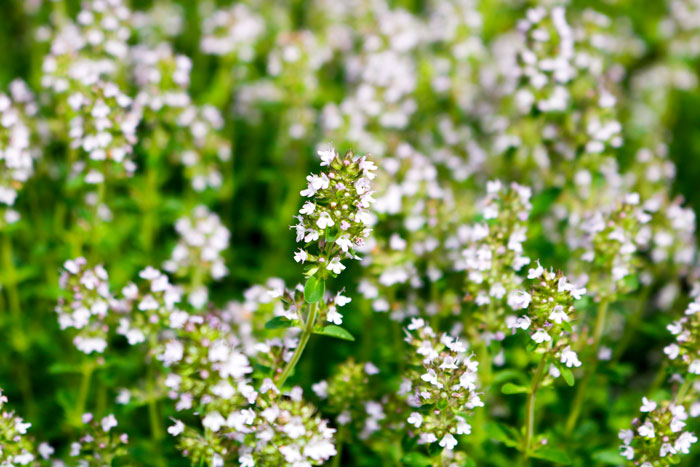
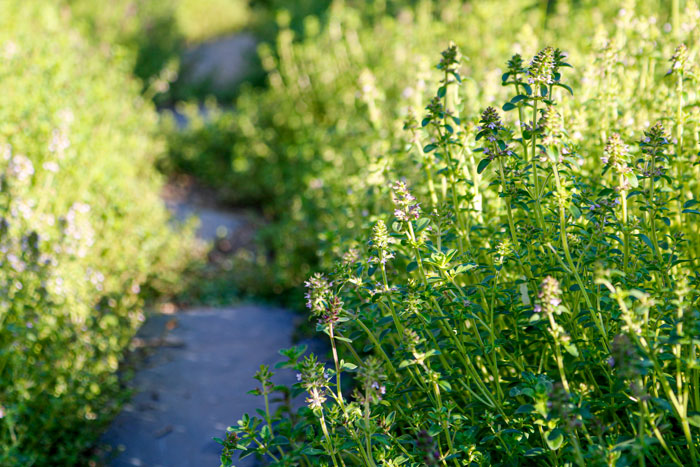
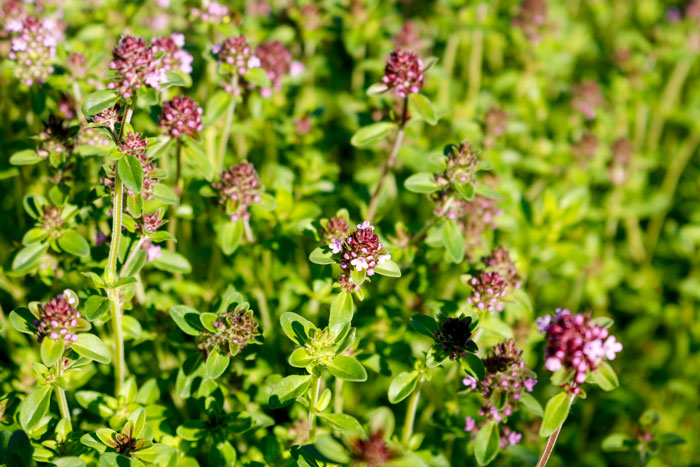
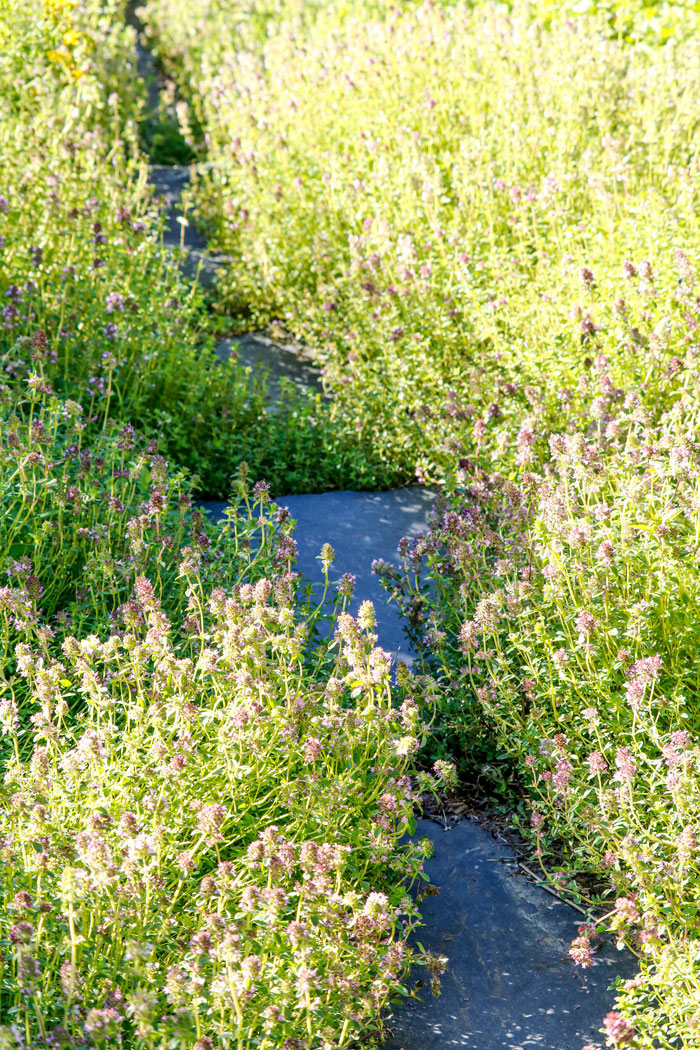
Oh my goodness, I’ve never planted such miniscule seeds before. They seem to come up and then disappear. I noticed you said just to spray them with the spray bottle for a while so I’m going to try that now to see if I have better luck because they seemed to always sort of rot away. Any other tricks to get them to actually grow beyond their cotyledon? Thank you!
Hi, Pamela, Yes, I agree, these seeds are quite minuscule. This can make keeping track of these seeds whereabouts and their growth rate challenging. In my experience, I have found a few things help creeping thyme grow here in Western Maine. The spring here is very challenging for growing. I usually wait until the end of June or early July, to start my seeds outdoors in a controlled environment such as clear containers or flower boxes. I prefer clear containers because I can see from the sides if the conditions are getting too wet. I have found during this point in the growing season, the temperatures are warm enough and the seeds are getting proper aeration. This way, you can also bring them indoors or a better location outdoors, if you feel the seeds and soil are getting too wet. To sum things up and in my opinion, I think temperature, aeration, and soil moisture are key components for successful growth. Like I mentioned in this post, I have had great success with this brand of seed if that helps. Perhaps, you can try starting your seeds indoors as well as outdoors and see which option works better for you.
Please let me know if you have any other questions and I would like to hear how you make out with the growth of your creeping thyme seeds. Good luck!
And how ar ed your garden paths looking this year, by-the-way?
Is it possible to just sew the seeds directly into the front edge of my retaining wall garden? It sounds like successful germination is a little trickier than that.
Hi Jill, You can probably go ahead and try sowing your seeds in the area you would like your creeping thyme to grow. If you are concerned about successful growth, maybe, you can try starting half of your seeds in a separate container and the other half directly into the desired area of growth. Please let me know how this goes and if you have any more questions. Thank you, Laura
Great instructions.
One question. It seems that you planted a bunch of seedlings from the plastic container to the ground. And you also suggest to plant them 8-12 inches apart. Did you separate each seedling and plant them 8-12 inches apart or did you plant them altogether at the same spot?
Hi Mark, Thank you and that is a great question. Actually, I tried planting my seedlings both ways. I found that in the places that I needed more growth, I could get away with bunches and in the smaller sections, I could separate my seedlings and then plant them 8-12 inches apart. I believe once they were established in the ground, they began to spread and thrive wonderfully. I hope I answered your question and please let me know if you have anymore. Thank you, Laura.
This is my first time propagating, and when the tiny sprouts looked a big leggy I trained a small fan on them, very low speed. It made them sturdier. Now when it warms up I’ll transplant the little peat plugs into the ground.
Berkshires, Western MA
Hi, Pat,
This sounds like a great plan and please let me know how your transplanting goes this spring.
Take care,
Laura
I have read that creeping thyme can be used as a lawn replacement. I am building a large pole barn in Northern Wisconsin, zone 4, surrounded by a wooded area, both pine and haedwoods. The site receives partial sun. Im looking for a low maintenance ground cover to surround the building in lieu of a grass lawn…approximately 7 to 10,000 sf. Can I direct sow creeping thyme seed and what is the success ratio of such an endeavor? Your thoughts
Hi Tim, This sounds like quite the endeavor! Creeping thyme is such a wonderful idea for a lawn replacement, making sure to not ignore the fact there are many factors to consider. I believe you are going to have to try a little trial and error. I can’t really say what your success ratio will be for such a large area but with a lot of time and patience, you should see results. I also found this info for you and I hope this helps. https://deepgreenpermaculture.com/2016/01/21/lawn-alternatives-creeping-thyme/ Please let me know how your project goes! Take care, Laura
Hi Laura some sites suggest soaking the seeds for 24 hrs what are your thoughts on soaking or just separating ?
Hi Pamela,
Yes, I have read about the soaking the seeds method as well. I never have and I have always had success in getting seeds to grow. Perhaps, you can try with and without doing so and see which option works best for you. Please let me know how you make out.
Thank you,
Laura
This has been helpful, thank you! I am in Colorado and the season here is fairly short. I have started my creeping thyme seeds indoors in flats but so far, the leaves have not gone beyond the early stage – I think these are called cotyledon. Do you suggest planting outdoors at this point or should I wait until they have their more mature leaves? And if so, how long does this typically take?
Hi Anne,
I’m glad you found this post helpful and you are very welcome. I’m not exactly sure where your plants are visually in the 14-21 day growing time, but it seems you are well on your way. If you are unsure, maybe give them a week to get a bit stronger. When you feel they can withstand the elements, you can go ahead and plant them in the ground or place your containers outside first to get them acclimated to the outdoors. I hope this helps and please let me know if you have any more questions. Also, I would love to see how your creeping thyme turns out.
Take care,
Laura
I live in Hawaii and it’s late July.
Can I plant seeds in containers now? Will they need constant sun as it has gotten very hot like all across the mainland.
This is my 1st attempt so all the info you can give me will help?
Hi Chris, Yes, I would recommend starting your seeds in containers, this way you can control how much sunlight and moisture your seeds/plants are receiving each day. If you find they are receiving too much sunlight, simply place them in a shaded area. You can always hold onto your seeds and wait until next year’s growing season. Please let me know if you need anything else. Good luck to you! – Laura
Can you plant on existing lawn? Or does all grass have to be removed first?
Hello Finbarr,
I believe it would be beneficial to kill the grass completely before planting anything new. Creeping thyme does a wonderful job at keeping the weeds and edges of lawns at bay but a whole lawn would be pretty overwhelming. I would first remove the grass due to the fact there are species of grass that are spread by runners and will then can re-establish themselves and eventually take over the thyme. This way, you can prep your soil with a fresh start and enjoy watching your thyme grow. I hope this answers your questions and please let me know if you have any more.
Take care, Laura
Hi,
I’m in Iowa, where the temp is currently 7°. The danger of frost won’t be gone until late April (probably). I’m wondering at what point I should start the seeds I have in order to have some good size plants to start in early May.
Thanks!
Hi Jim,
Being that it will take about three weeks for your seeds to germinate, perhaps, you can start your seeds indoors at the end of March/beginning of April under good lighting. I’m not sure if they would be the height you are aiming for but I’m sure once they are ready for outdoors, they should take off quite nicely. I hope I have answered your question and please let me know if you have any others.
Thanks,
Laura
Thank you for documenting your process with starting creeping thyme from seed. I made the mistake of starting them in peat moss pellets and they are lanky and dying off due to the peat moss retaining so much moisture. I’ll now be trying the black gold potting soil in large containers and trying to cover the seeds with a little soil. Appreciate all the info you’re giving out you rock!
Thank you for your kind words, Ryan. I hope that your attempt is successful this time and please let me know how it goes! Take care, Laura
I am using a biodome for my seeds and they have sprouted nicely, but they are very “leggy”…I have a lot of them, but I wouldn’t say that they could take a transplant and survive. instructions for the biodome don’t say much. I do have a lot of water in the pan…looking for a suggestion…obviously they sprouted but I wouldn’t call this successful…wondering if I should transplant all of them (there were 60 plugs and there are way more sprouts on each one) to a container … live in north georgia and we will be getting frost mid october?? I wouldn’t want to plant them now, but I am not sure how to keep them healthy for the Spring….
Hi, Gina, It seems like you’re in a tough spot. I suppose you can go ahead and plant what you have or plant only half and see what happens either way. I don’t have experience with biodomes, so I can’t comment on that. You may have to start over next spring. These plants are hearty and you shouldn’t have a problem with starting over if needed. I wish that I could be more helpful. Please let me know how you make out. Take care, Laura
I’m in zone 8b, SW Washington State. My last frost date is approx. April 15th. It’s mid-March, so I have one more month to go for that. I currently have two 200-cell trays with Creeping Thyme in a heated grow tent and under lights in my (unheated garage). Several of the seedlings (I’m guessing 60%) have 2 sets of true leaves. They are currently in seed starting mix and my goal is to plant them around flagstone.
1) I don’t have any additional room in my 14”x36” 4-shelf grow tent. If I were to pot them up. Would it be okay to put them outside in natural light on mild temperature days and then move them indoors at night?
2) At what stage do creeping thyme seedlings need a more nutrient-rich soil for growth? Again, they are currently in a seed starting mix that doesn’t have anything really of value nutrient-wise. I usually start transitioning my other seedlings into the potting mix after their first 1-2 sets of true leaves appear.
I’ve never grown Creeping Thyme before and I’m struggling to find much, if any information out there. Most of the directions I see are to grow the seeds, “keep them moist and then plant them in soil that drains well”….boom, that’s it. I need help!
Thank you!
Hello Alyssa,
Thank you for contacting me. You can slowly acclimate your creeping thyme seedlings to the outdoor temperatures by moving them outdoors on mild days, then bring them back indoors. Increase the sunlight by an hour each day. This will help them acclimate to the outdoors and prevent shock. Perhaps you can wait until your seedlings are about one inch in size and then add a small amount of soil. After they’ve established roots and grow to about two to three inches, you can go ahead and transplant them outside after the last frost. I wish you luck and planting around flagstone sounds perfect! Please let me know if you have any more questions. – Laura G.